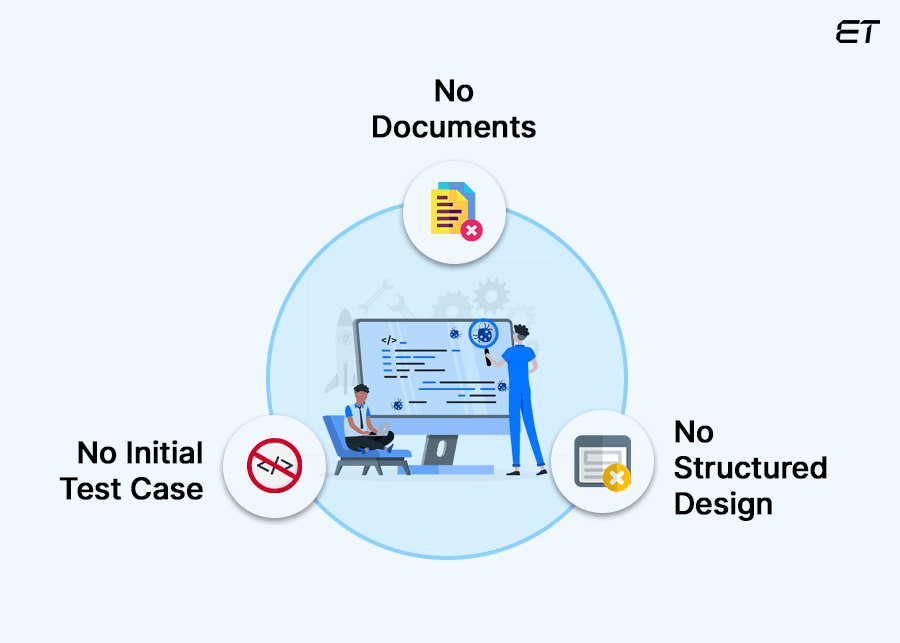
Ad Hoc Testing: Concept, Process, and Benefits
The QA segment in software development is highly structured. However, one underrated name can prove that even intuition works wonders. Enter ad hoc testing – the unrecognized asset.
This unstructured testing approach is helpful in finding intangible bugs that can slip through the scope of planned testing. Unlike other evaluation techniques, ad hoc testing builds on unpredictability. It encourages QA experts to explore the testing process without predefined test cases.
But what exactly does it mean to perform ad hoc tests? And are they beneficial for your business?
Let’s explore its concept, process, and the significant benefits it brings to software development.
What is Ad Hoc Testing: The Concept

In simple words, ad hoc testing is a spontaneous and unstructured approach to software testing. In this type of evaluation, QA testers explore the digital application without following predefined test cases.
It’s similar to a random exploration of the software’s functionalities, aiming to uncover unexpected defects or vulnerabilities.
Unlike structured testing methods, ad hoc tests rely on the QA professional’s intuition, experience, and creativity. It’s a flexible approach that you can apply at any stage of the software development lifecycle. It’s true that ad hoc tests can seem chaotic initially. However, these results reveal defects that other testing methods can miss.

Need expert QA engineers to test your software proficiently? Then, connect with us and benefit from the assistance of vetted ISTQB-certified professionals.
What is the Process of Ad Hoc Testing?

Ad hoc tests follow a specific pattern. This section elaborates on the general steps involved in this QA testing service.
1. Understand the Application

A deep understanding of the software or web application is crucial for effective ad hoc testing. This preliminary step involves more than just knowing the basic functionalities; it requires an all-inclusive product view.
Here’s what this step entails:
- Core Functionalities: A clear grasp of the primary purpose of the application and the key features it offers
- Target Audience: Understanding the end-users, their needs, and how they interact with the application
- User Flows: Knowledge of common user journeys and interactions within the application
- Technical Aspects: Basic understanding of the underlying technology, architecture, and dependencies
- Business Requirements: Familiarity with the business goals and objectives the application is designed to meet
By fully understanding the application, QA engineers can focus their exploration on areas that are more likely to uncover defects and provide valuable insights. This knowledge also helps prioritize defects and communicate their impact effectively.
2. Explore the Digital Product

Spontaneous exploration is the foundation of ad hoc testing. This step includes breaking free from the constraints of predefined test cases and letting your curiosity guide you.
Here’s a deeper look into this process:
- Engage with the web application without any specific plan, trying random combinations of inputs, buttons, and menus
- Follow your instincts to explore different paths and functionalities within the application
- Deliberately test the boundaries of the application to uncover unexpected behaviors
- Provide invalid or unexpected inputs to see how the application responds
- Imitate real-world user behavior, including making mistakes or performing actions out of order
Remember, the goal is to uncover defects that might be missed by structured ad hoc testing.

Curious to understand how we test software at our Clutch-recognized organization? Then, read our blog that explains the fundamental steps taken by our vetted professionals.
3. Report the Defects

Defect reporting is an essential step in the ad hoc testing process. Consider it the bridge between the tester’s discovery and the developer’s solution.
To ensure effective defect resolution, providing clear, concise, and reproducible information is essential. Here’s what a good defect report should include:
- A brief summary of the defect
- Clear explanation of the problem
- A step-by-step guide on how to recreate the defect
- An assessment of the impact of the defect on the application
- Visual evidence can be invaluable in comprehending the issue
- Information about the operating system, browser, and other relevant system information
Using a defect tracking tool can streamline the ad hoc testing process and facilitate communication between testers and developers.
4. Create Additional Test Cases

It’s vital to realize that ad hoc testing is inherently unplanned. However, there are instances where creating a formal test case after discovering a defect can be beneficial.
This strategy is useful for critical issues that significantly impact the application.
Here’s why creating a test case can be valuable:
- A well-structured test case ensures that other developers can reproduce the defect
- Including the test case in the regression test suite helps prevent the defect from reappearing in future releases
- The test case serves as documentation of the defect and the steps to reproduce it
- Adding the test case to the overall test suite improves test coverage.
However, it’s essential to balance the benefits of test case creation with the project’s time constraints. Documenting the defect in the bug-tracking system might be sufficient in some cases.
So, you should create a test case based on the severity of the defect, the available resources, and the overall testing strategy.

At eLuminous, we have a specialized QA department that works on global testing projects. Explore our services to know more about our scope and utility.
Benefits of Ad Hoc Testing
It’s true that ad hoc testing is unstructured in nature. However, this QA approach offers several advantages in the software development process. This section briefly explains some of the main ones.
| Benefit | Explanation |
| Uncover Unexpected Defects | The spontaneous approach of ad hoc testing reveals bugs that might be missed by structured testing methods |
| Enhance Test Coverage | By exploring the application in an unplanned manner, testers can cover areas that might not be included in formal test cases |
| Stimulates Creativity | Ad hoc testing encourages testers to think outside the box and explore different testing angles |
| Cost-effective Approach | This type of testing requires minimal planning and documentation, making it a relatively inexpensive testing method |
| Improvement in Testing Skills | Regular ad hoc testing can enhance a tester’s ability to identify potential issues and develop a detailed comprehension of the application |
Endnotes on Ad Hoc Testing
Ad hoc testing can be a great asset to your quality assurance strategy. By prioritizing impulse and relying on tester instinct, this method can uncover critical defects that might escape structured testing. Its ability to enhance test coverage, stimulate creativity, and provide rapid feedback makes it invaluable to any development team.
By incorporating ad hoc testing into your development process, you can take a proactive step towards delivering robust and reliable software.
If you want to explore the utility of ad hoc testing, our team of vetted QA experts can help. We can identify and address hidden issues before they impact your users. So, contact us today to explore our services and understand how we can elevate the quality of your software.
Frequently Asked Questions
1. Can ad hoc testing replace scripted testing?
No, ad hoc testing is complementary to scripted testing. So, you cannot perceive it as a replacement. While ad hoc testing uncovers unexpected issues, scripted testing ensures consistent coverage of critical functionalities. A combination of both approaches provides comprehensive test coverage.
2. How do I measure the effectiveness of ad hoc testing?
Due to its unstructured nature, measuring the effectiveness of ad hoc testing can be challenging. However, you can track the defects found through ad hoc testing and compare them to other testing methods. Additionally, analyzing the severity of defects discovered through ad hoc testing can provide insights into its impact.
3. What role does a QA tester’s work experience play in ad hoc testing?
The work experience of a QA tester or engineer is crucial for successful ad hoc testing. Experienced testers have a better understanding of potential issues. Also, they can identify areas prone to errors and develop creative test scenarios.
4. How can I integrate ad hoc testing into my existing testing process?
You can integrate ad hoc testing into various stages of the software development lifecycle. Consider dedicating specific time slots for conducting ad hoc tests. Also, you should encourage exploratory testing during regular testing cycles. Involving the entire team in ad-hoc testing sessions can prove impactful.





